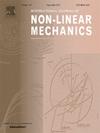弹性支承干摩擦阻尼器在机动飞行双旋翼系统中的减振特性
IF 2.8
3区 工程技术
Q2 MECHANICS
International Journal of Non-Linear Mechanics
Pub Date : 2025-02-13
DOI:10.1016/j.ijnonlinmec.2025.105041
引用次数: 0
摘要
为了进一步研究弹性支承干摩擦阻尼器的综合减振性能,建立了弹性支承干摩擦阻尼器在机动飞行下的双转子系统有限元模型,通过能量对应和等效节点载荷简化了梁单元运动方程的推导过程。采用Newmark - β和轨迹跟踪法求解系统的瞬态动态响应。提出了一种描述转子整体减振效果的评价指标DRMS。研究了阻尼器在双转子系统中的减振特性以及受机动载荷作用下的减振特性。结果表明:(1)将盘的运动方程推广到梁单元时,不需要将广义位移或广义速度的一阶能量项代入拉格朗日方程,而可以通过等效节点荷载获得动力学方程中的外力项。(2)机动载荷的影响主要由附加惯性力引起的转子平衡位置偏移所主导,特别是当集中质量发生在支撑跨度较大的轴段时。(3)在最佳安装位置和法向力下,阻尼器可同时减小最大振幅和整体振动。(4)阻尼器的附加刚度可以限制机动飞行下弹性支承处平衡位置的偏移。粘杆状态可以将这种偏移量限制到最小,并且每个阻尼器的最佳法向力可以从瀑布图的直流分量中得到。本文章由计算机程序翻译,如有差异,请以英文原文为准。
Vibration reduction characteristics of elastic support dry friction dampers in a dual-rotor system under maneuvering flight
To further study the comprehensive vibration reduction performance of the elastic support dry friction damper, the FE model of dual-rotor system with elastic support dry friction damper under maneuvering flight is established, in which the derivation process of the beam element motion equation is simplified by the energy correspondence and the equivalent node load. The transient dynamic response is solved by and the trajectory tracking method. An evaluation index for describing the overall vibration reduction effect of the rotor is proposed. The vibration reduction characteristics of the damper in the dual-rotor system as well as those subjected to the maneuvering load are investigated. The results show that: (1) When the motion equation of the disk is extended to the beam element, it is not necessary to substitute the first-order term of the energy about the generalized displacement or the generalized velocity into the Lagrange equation, and the external force term in the kinetic equation can be obtained through the equivalent node load. (2) The effect of the maneuvering load is mainly dominated by the offset of the rotor equilibrium position due to additional inertial force, especially when the concentrated mass occurs in the shaft section with a large support span. (3) Under the optimal installation position and normal force, the damper can reduce the maximum amplitude and overall vibration at the same time. (4) The additional stiffness of the damper can limit the offset of the equilibrium position at the elastic support under the maneuvering flight. The stick state can limit this offset to a minimum, and the optimal normal force of each damper can be obtained from the DC component of the waterfall diagram.
求助全文
通过发布文献求助,成功后即可免费获取论文全文。
去求助
来源期刊
CiteScore
5.50
自引率
9.40%
发文量
192
审稿时长
67 days
期刊介绍:
The International Journal of Non-Linear Mechanics provides a specific medium for dissemination of high-quality research results in the various areas of theoretical, applied, and experimental mechanics of solids, fluids, structures, and systems where the phenomena are inherently non-linear.
The journal brings together original results in non-linear problems in elasticity, plasticity, dynamics, vibrations, wave-propagation, rheology, fluid-structure interaction systems, stability, biomechanics, micro- and nano-structures, materials, metamaterials, and in other diverse areas.
Papers may be analytical, computational or experimental in nature. Treatments of non-linear differential equations wherein solutions and properties of solutions are emphasized but physical aspects are not adequately relevant, will not be considered for possible publication. Both deterministic and stochastic approaches are fostered. Contributions pertaining to both established and emerging fields are encouraged.

 求助内容:
求助内容: 应助结果提醒方式:
应助结果提醒方式:


